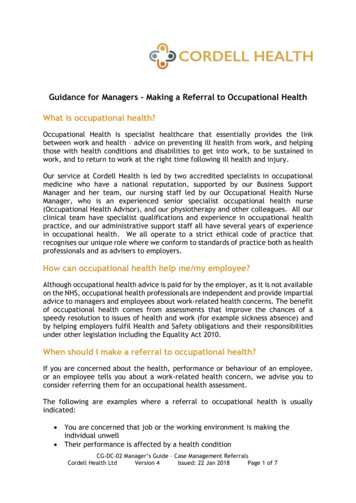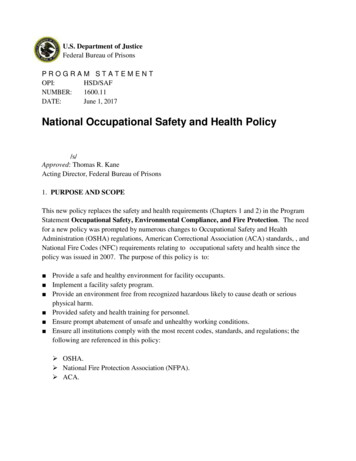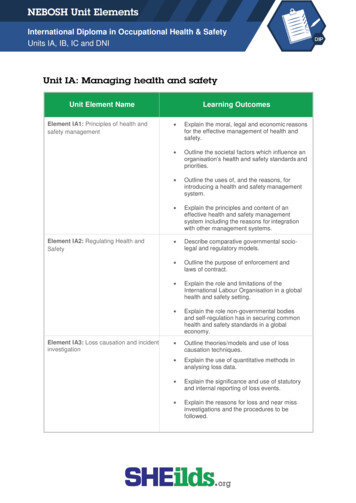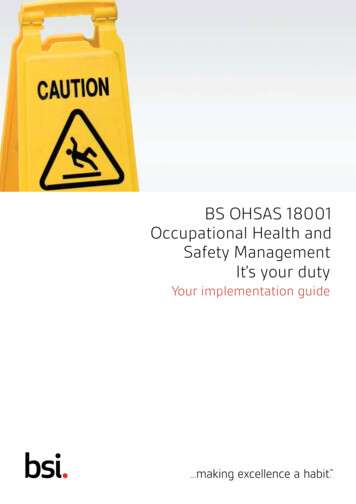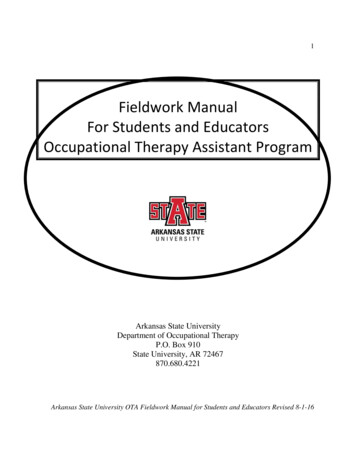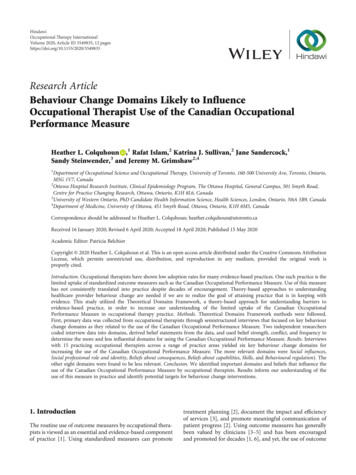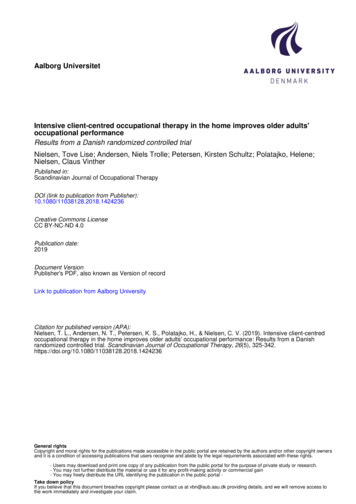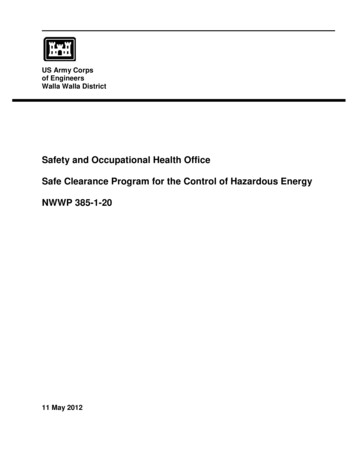
Transcription
US Army Corpsof EngineersWalla Walla DistrictSafety and Occupational Health OfficeSafe Clearance Program for the Control of Hazardous EnergyNWWP 385-1-2011 May 2012
NWWP 385-1-2011 May 2012SAFE CLEARANCE PROGRAMFOR THE CONTROL OF HAZARDOUS ENERGYTABLE OF CONTENTSParagraphPageChapter 1 – Introduction1-1.1-2.1-3.1-4.1-5.1-6.Purpose . 1-1Applicability . 1-2References . 1-2Definitions . 1-3Authority . 1-3Effective Date . 1-3Chapter 2 – sible Official . 2-1Issuing Individual. 2-2Principal Authorized Individual (PAI) . 2-3Authorized Individual . 2-4Affected Personnel . 2-4All Employees . 2-4Incidental Persons. 2-5Chapter 3 – Policies and Rules3-1.3-2.General . 3-1Procedural Requirements. 3-1Chapter 4 – Emergency Procedures4-1.4-2.4-3.Suspension of Requirements . 4-1Safety of Personnel . 4-1Emergency Switching . 4-1Chapter 5 – Training5-1.5-2.5-3.5-4.5-5.5-6.5-7.5-8.General . 5-1New Employees . 5-1Awareness Training . 5-1Affected Personnel Training . 5-1Authorized Individual Training . 5-2Issuing Individual Training . 5-2Retraining . 5-3Equipment Changes and Retraining . 5-3i
NWWP 385-1-2011 May 20125-9.5-10.Training Documentation . 5-3Training of Contractors . 5-3Chapter 6 – Locks and Tags6-1.6-2.6-3.Locks and Lockout Devices. 6-1Tags . 6-2Tag and Label Requirements . 6-3Chapter 7 – Hazardous Energy Control .7-11.7-12.7-13.7-14.Safe Clearance Request . 7-1Isolation Procedures . 7-2Accepting and Issuing the Safe Clearance. 7-3Group Safe Clearance . 7-3Temporary Protective Grounds (TPG) . 7-5Adding or Releasing Safe Clearance Locks and Tags (Energy IsolationPoints) on an Existing Safe Clearance . 7-7Temporary Removal of Locks and Tags (Temporary Lifts) . 7-9Releasing a Safe Clearance. 7-12Transferring a Safe Clearance . 7-13Multi-Shift Safe Clearance. 7-13Release of the Safe Clearance When the PAI is Absent . 7-14Safe Clearance Status Changes When Personnel are Absent . 7-16Loss of a Group Clearance Form (Master Tag). 7-18Safe Clearances at Remote Sites . 7-18Chapter 8 – Personal Lockouts and Operational Permits8-1.8-2.Personal Lockout . 8-1Operational Permits . 8-3Chapter 9 – Caution Orders9-1.9-2.9-3.9-4.9-5.9-6.9-7.Purpose . 9-1General . 9-1Identification . 9-1Issued and Released . 9-1Documentation . 9-1Caution Order Form (ENG Form 1928) . 9-1Caution Order Tags (ENG Form 1924) . 9-1Chapter 10 – Outside/Contractor Personnel10-1.10-2.General . 10-1Submittals . 10-1ii
NWWP 385-1-2011 May 201210-3.10-4.Coordination . 10-1Incidental Persons. 10-2Chapter 11 – Committees, Inspections, and Program Review11-1.11-2.11-3.11-4.District Safe Clearance Committee . 11-1Project Safe Clearance Committee . 11-1Periodic Inspections . 11-1Corrective Action . 11-2APPENDIXESAppendix A – DefinitionsAppendix B – Sample Hazardous Energy Control Program (HECP) Forms and TagsAppendix C – Applicable Equipment for Personal Lockout/OperationalPermits – ExampleAppendix D – Personnel Authorizations – ExampleAppendix E – Engineering Regulation 385-1-31, The Control of Hazardous EnergyAppendix F – Safe Clearance Lock Box Storage LocationsAppendix G – Bonneville Power Administration Accident Prevention Manual,Section S-6, Switching and Clearance Procedureiii
NWWP 385-1-2011 May 2012iv
DEPARTMENT OF THE ARMYNWWP 385-1-20WALLA WALLA DISTRICT, CORPS OF ENGINEERS201 NORTH THIRD AVENUEWALLA WALLA WA 99362-1876REPLY TOATTENTION OF:CENWW-SOPamphletNo. 385-1-2011 May 2012Safety and Occupational Health OfficeSAFE CLEARANCE PROGRAM FOR THE CONTROL OF HAZARDOUS ENERGYChapter 1 – Introduction1-1. PURPOSE. This U.S. Army Corps of Engineers (Corps), Northwestern Division,Walla Walla District (District), Pamphlet (NWWP), prescribes policies and proceduresfor the Safe Clearance Program for the control of hazardous energy at all facilities in theDistrict.a. The policies and procedures of this NWWP are intended to:(1). Safeguard personnel whose operating, maintenance, construction,testing, or research duties require them to work on or near equipment in which theunexpected energizing, startup, or release of any form of hazardous energy could causepersonal injury or property damage.(2)Prevent equipment damage.(3) Protect the environment (from release of lubricating oil, control fluids,hydraulic oil, etc.).b. The following appendixes are included in this NWWP:(1) Appendix A – Definitions. This appendix includes definitions pertinentto this NWWP.(2) Appendix B – Sample Hazardous Energy Control Program (HECP)Forms and Tags. This appendix includes samples of forms and tags used in theprocedures outlined in this NWWP.1-1
NWWP 385-1-2011 May 2012(3) Appendix C – Applicable Equipment for Personal Lockout/OperationalPermits Example. This appendix provides an example to assist each project indeveloping their own Applicable Equipment for Personal Lockout/Operational Permits.(4) Appendix D – Personnel Authorizations Example. This appendixprovides an example to assist each project in developing their own PersonnelAuthorizations.(5) Appendix E – Engineering Regulation 385-1-31, The Control ofHazardous Energy. This appendix provides a link to Engineering Regulation (ER)385-1-31.(6) Appendix F – Safe Clearance Lock Box Storage Locations. Thisappendix identifies where Safe Clearance Lock Boxes should be stored.(7) Appendix G – Bonneville Power Administration Accident PreventionManual, Section S-6, Switching and Clearance Procedure. This appendix providesDistrict Issuing Individuals with guidance for issuing and receiving clearances, terminalclearances, hold orders, and terminal holds on transmission lines connecting toBonneville Power Administration (BPA).1-2. APPLICABILITY. The policies and procedures prescribed in this NWWP areapplicable to all employees of the District. This NWWP meets minimum lockout/ tagoutrequirements for general industry and construction activities.1-3.REFERENCES.a. 29 Code of Federal Regulation (CFR) 1910.147, The Control of HazardousEnergy (Lockout/Tagout).b. 29 CFR 1910.269, Electric Power Generation, Transmission, andDistribution.c.29 CFR 1910.333, Selection and Use of Work Practices.d. ER 385-1-31, Safety and Occupational Health – The Control of HazardousEnergy. See appendix E.e. Engineer Manual (EM) 385-1-1, Safety and Health Requirements Manual.f. American National Standards Institute (ANSI) C2, National ElectricalSafety Code.1-2
NWWP 385-1-2011 May 2012g. Occupational Safety and Health Administration (OSHA) InstructionSTD 1-7.3, The Control of Hazardous Energy (Lockout/Tagout) – Inspection Proceduresand Interpretive Guidance.h. BPA, Accident Prevention Manual, Section S-6, Switching and ClearanceProcedure, September 1, 2007.1-4.DEFINITIONS. Refer to appendix A.1-5.AUTHORITY. The authority for this NWWP is ER 385-1-31.1-6.EFFECTIVE DATE. This NWWP is effective upon publication.1-3
NWWP 385-1-2011 May 20121-4
NWWP 385-1-2011 May 2012SAFE CLEARANCE PROGRAM FOR THE CONTROL OF HAZARDOUS ENERGYChapter 2 – Responsibilities2-1. RESPONSIBLE OFFICIAL. The Responsible Official at each project or facilityhas overall responsibility for the project's Safe Clearance Program and associatedHECP procedures, and shall ensure that the requirements of this NWWP are properlyapplied and adhered to.a. The Operating Project Manager (OPM) is the Responsible Official and hasoverall responsibility for the project’s HECP. If no OPM is responsible for the locationwhere operations and maintenance is being conducted, the person in charge of thefacility is the Responsible Official.b. The Responsible Official designates, in writing, the Issuing Individuals(Issuing Authority) and Authorized Individuals (see appendix D).(1) If a person requests a safe clearance and is not listed as an AuthorizedIndividual (see appendix D), the Responsible Official may elect to grant temporarywritten authorization. This temporary written authorization shall be provided to theIssuing Individual.(2) The Responsible Official or designee is responsible for alladministrative aspects of the HECP, including:(a)Training and testing.(b)Annual review and record keeping.(c)Overseeing Safe Clearance Committee activities.(d)Drafting proposed revisions to the HECP.(e)Monitoring program compliance.(f) Authorizing mission-essential systems and equipment forremoval from service.(g) Ensuring maintenance and retention of all safe clearances,personal lockouts (both single and multiple point), and caution order records.(h) Preparing or directing the preparation of written procedures forclearing out equipment and the placement of tags and locks.2-1
NWWP 385-1-2011 May 2012(i) Maintaining a file or manual of written procedures and making itavailable to all Affected Personnel.(j) Promptly preparing HECP procedures whenever new or modifiedequipment or changes in operating procedures or practices make it necessary.(k) Coordinating HECP procedures between project operating andmaintenance personnel, resource personnel, and contractors or other affected off sitepersonnel.(l) Ensuring contractors and other affected Government ornon-Government off-site personnel are trained and comply with the provisions of theHECP.(m) Investigating alleged violations. Take corrective action asnecessary.2-2. ISSUING INDIVIDUAL. The Issuing Individual maintains control of hazardousenergy sources and operating equipment and systems, including the Safe ClearanceSoftware Program. Upon issuance of a safe clearance, the Issuing Individualtemporarily relinquishes control of equipment to the PAI for the accomplishment ofservicing and maintenance work. The Issuing Individual shall:a. Verify that the requester is authorized to be issued a safe clearance.b. Verify that an approved Activity Hazard Analysis (AHA) (NWW Form 385-1)(see appendix B) has been submitted.c. Review requests for safe clearances and switching orders, and consult withthe person who requested the safe clearance to ensure that adequate protection isprovided to personnel and equipment for the work to be performed.d. Ensure the preparation of the safe clearance paperwork.e. Make all necessary arrangements for interruption of services, includingnotification of customers.f. Coordinate with agencies and other entities to ensure isolation of systemsthat are to be cleared.g. Ensure the application and removal of lockout devices and tags according toprocedures.h. Record all safe clearance operations as required.2-2
NWWP 385-1-2011 May 2012i. Maintain awareness of equipment condition and status during thesafe clearance.j. Ensure the equipment is ready for service after work has been completed.Ensure that all Authorized Individuals have released their safe clearances and removedtheir locks.k. Provide oversight to ensure that all parties follow the provisionsof the HECP.l. Ensure Temporary Protective Grounds (TPG) are installed and hang TPGtags (see appendix B).m. Delegate duties to a designated alternate as appropriate, except for issuingand releasing safe clearances; authorizing changes of status; and making Station LogBook entries. See “Issuing Individual Designated Alternate” in appendix A.2-3. PRINCIPAL AUTHORIZED INDIVIDUAL (PAI). This is the Authorized Individualwho requested and holds the safe clearance. The PAI, also called Clearance Holder,shall:a. Request safe clearances and submit an approved AHA (NWW Form 385-1)(see appendix B) for the work.b. Review the safe clearance request with the Issuing Individual to ensure itprovides adequate protection for the work to be done.c. Verify the correct positioning of all energy isolation points and the correctplacement of lockout/tagout devices.d. Verify installation of all required physical barriers and TPGs.e. Be responsible for the application and removal of safe clearance locks.f.manner.Verify hazardous energy is relieved, bled off, or otherwise released in a safeg. Assume responsibility for the system under safe clearance until:(1)All work is done.(2)All personnel, tools, and equipment are in the clear.(3)All grounds, barriers, and jumpers are removed.(4)The safe clearance is released to the Issuing Individual.2-3
NWWP 385-1-2011 May 2012h. Keep the Issuing Individual informed of the status of the work.i.Coordinate with other PAIs and Affected Personnel as required.j. Obtain permission from the Issuing Individual before making any change tothe status of the safe clearance.k. Assume full responsibility for safeguarding the Group Clearance Form(Master Tag) (see appendix B) and ensure all Affected Personnel sign on and off thesafe clearance per procedures, legibly and in ink.l. Ensure the work is completed and equipment is ready for service beforereleasing the safe clearance.m. Report to the Issuing Individual any circumstances not meeting therequirements of the HECP.2-4. AUTHORIZED INDIVIDUAL. Authorized Individuals are qualified to hold safeclearances, operational permits, and personal lockouts as identified by the ResponsibleOfficial (see appendix D). An Authorized Individual may act in the capacity of a PAI oran Affected Person as appropriate.2-5. AFFECTED PERSONNEL. Affected Personnel perform servicing andmaintenance within the boundary of the safe clearance. All Affected Persons shall:a. Verify that the safe clearance provides adequate protection for thework to be performed prior to signing on the Group Clearance Form (Master Tag)(see appendix B).b. Report to the Issuing Individual any circumstances not meeting therequirements of the HECP.c. Obtain permission from the PAI prior to performing work under a safeclearance.d. Sign on and off, in ink, the Group Clearance Form (Master Tag).e. Hang and remove their personal locks as required.2-6. ALL EMPLOYEES. All employees shall report procedural errors or allegedviolations to the Issuing Individual, their supervisors, or the Responsible Official. Allpersonnel shall demonstrate a spirit of cooperation and shared responsibility for theimplementation of the HECP. Any potentially unsafe conditions shall be reported tothe Issuing Individual.2-4
NWWP 385-1-2011 May 20122-7. INCIDENTAL PERSONS. Incidental Persons include visitors and vendors alongwith others who are allowed to enter, perform inspections, and view the area affected bythe safe clearance. All visitors and vendors must be given training to include instructionregarding HECP procedures and the prohibition of removing a lockout or tagout.a. All vendors and visitors shall be escorted at all times by the PAI, anAuthorized Individual, or an Affected Person.b. Escorts are responsible for signing on/off the Group Clearance Form (MasterTag) (see appendix B) and denoting the number of people escorted.c.Escorts shall hang or remove their personal locks as required.2-5
NWWP 385-1-2011 May 20122-6
NWWP 385-1-2011 May 2012SAFE CLEARANCE PROGRAM FOR THE CONTROL OF HAZARDOUS ENERGYChapter 3 – Policies and Rules3-1. GENERAL. The intent of this policy is to protect personnel, equipment, and theenvironment from damage through the use of HECP procedures. All energy sourcesshall be controlled before performing work, service, or maintenance on equipment. Incircumstances requiring safe clearances, personnel and resources shall not beconsidered protected until all HECP procedures and special instructions have beencompleted.a. A copy of the AHA (NWW Form 385-1) (see appendix B) shall be submittedwith the safe clearance request.b. Use lockout where isolation points are capable of being locked out. Tagsshall always accompany locks.c.locked.Tagout only is permitted when isolation points are not capable of beingd. Train personnel on the purpose and application of the HECP and associatedprocedures.e. Coordinate servicing and maintenance activities when more than oneemployer, workgroup, or facility is involved or affected.f.Perform periodic inspections to assure continued program compliance.g. All modified, rehabilitated, or new equipment shall be capable of acceptinglockout devices.h. Employees will be notified of their rights and responsibilities with regard toreporting unsafe conditions and/or procedures.3-2.PROCEDURAL REQUIREMENTS.a. Before any task is performed, the worker shall determine whether theprovisions of paragraph 3-1 require a safe clearance. If one is required, personnel andequipment shall not be considered protected until all applicable measures of the HECPare completed.b. Only qualified personnel (Issuing Individual or Designated Alternate) shall bepermitted to perform the switching, valving, and tagging steps of the safe clearance.3-1
NWWP 385-1-2011 May 2012c. Issuing Individuals may receive safe clearances issued to the position for thefollowing conditions:(1) Line terminal clearances on tie lines and supply lines to and fromoutside utilities or the power marketing agency, BPA, to establish safe workingconditions within areas of high voltage equipment energized by these authorities. (Seeappendix G for BPA Accident Prevention Manual, Section S-6, Switching and ClearanceProcedure.)(2) To temporarily hold defective equipment out of service in emergencyconditions or prevent operation of malfunctioning equipment that might be damagedif operated.(3) In cases where emergency repair work is needed in order to restorecritical equipment to service and no Authorized Individuals are available to takeclearances.d. Requests for safe clearances should be made a minimum of 24 hours inadvance to give the Issuing Individual time to prepare. Large, complex, or missionessential clearances will typically require additional time to prepare, review, and toschedule outages. Professional consideration on behalf of both the requester and theIssuing Individual shall be observed.e. The following entries in the Station Log Book shall be in red ink:(1)Request of the safe clearance.(2)Issue of the safe clearance.(3)Adding a clearance point.(4)Installation of TPGs.(5)Adding TPG tags (see appendix B).(6)appendix B).(7)f.Temporary lifts and re-hangs of clearance points and TPG tags (seeChange of PAI on a multi-shift safe clearance.The following entries in the Station Log Book shall be in green ink:(1)Release of a safe clearance.(2)Release of TPG tags (see appendix B).3-2
NWWP 385-1-2011 May 2012(3)Removal of TPGs.(4)Release of a clearance point.g. Written standard HECP procedures, including switching orders, shall bedeveloped at each work site for all equipment supplied with multiple sources ofhazardous energy.h. Canned clearances should be used as a starting point or reference for therequested clearance, not a final trusted solution.i. The Responsible Official or designated alternate shall grant approval for theremoval from service of any equipment that may affect the mission of the project.j. All verbal communications shall be repeated back to avoid misunderstanding.This shall include the safe clearance number, equipment under safe clearance, changesto be made, and other relevant information.k. Prior to beginning work, all Affected Personnel should verify that stored orresidual hazardous energy is isolated, relieved, bled off, disconnected, restrained orabsent of voltage.l. All safe clearances shall have a Group Clearance Form (Master Tag) (seeappendix B) attached to the PAI copy of the Safe Clearance Order Form (see appendixB) to support the requirements for changes of status and group safe clearances.m. Locks will be used on all isolation points capable of being locked out. Safeclearance locks will only be applied to isolation points that have been positioned andhave a tag hung. Tags may be hung on the lock shank in the case of personal lockouts.n. When isolation points are not capable of being locked, then tagout only ispermitted. When tagout alone is used, the following conditions shall be met:(1)Personnel shall be instructed in the limitations of tags.(2) When a safe clearance tag (ENG Form 1925) (see appendix B) isattached to an isolation point, it shall be treated as being a locked point and shall neverbe operated with the tag attached.(3)Tags will be placed so they are readily identifiable as an isolation point.(4) Additional means shall be employed to provide a level of protectionequivalent to that provided by a lock. This can consist of any of the following:(a) Opening both the energy isolating circuit breaker and itsassociated disconnect.3-3
NWWP 385-1-2011 May 2012(b)Removal of a circuit element (i.e., a fuse).(c)Racking out or removing the circuit breaker.(d) Opening and applying a tagout to the circuit breaker (energyisolation device), opening the associated control switch or circuit, and applying a tagoutdevice to it.(e) Placing a blocking mechanism over the operating handle of adisconnect so that the handle is blocked from closing the circuit.(f)Grounding the circuit upon which work is to be performed.o. Computer software, or any other type of programming, shall not be used asan isolation point.p. The safe clearance lock sets shall be stored and maintained by the IssuingIndividuals. A safe clearance lock set will be issued to the PAI for isolation pointlockout. All excess locks will be placed in the Group Lock Box. After the safe clearancehas been released, the complete safe clearance lock set will be returned to the IssuingIndividual.q. Safe clearance lock boxes and Group Clearance Forms (Master Tag) shallnormally be located in a specified location as identified in appendix F.r. The PAI’s personal lock will be the first on the Group Lock Box and the last tobe removed.s. The PAI is not required to sign on to the Group Clearance Form (MasterTag), but will be cognizant of all Affected Personnel signing on to their safe clearanceand of the status of all work to be performed.t. All Affected Persons must coordinate with the PAI prior to signing onto asafe clearance. The PAI need not be present for Affected Persons to sign on to theirGroup Clearance Form (Master Tag) if they have signed on previously. Lackingcoordination, and in the absence of the PAI, written approval to sign onto the clearancemust be obtained from the PAI’s supervisor and provided to the Issuing Individual.u. Temporary lifts shall be of short duration.v. For diving operations, both the Government dive inspector and the dive crewsupervisor shall be issued a safe clearance.w. A Corps Quality Assurance Representative (QAR), when authorized, may beissued a safe clearance. The QAR shall not receive a safe clearance for a contractor.3-4
NWWP 385-1-2011 May 2012x. Safe clearance violations are taken very seriously since they can result ininjury, damage to equipment, or loss of life. The Responsible Official shall ensure thatalleged violations are investigated. Violators of this program may require training andretesting.3-5
NWWP 385-1-2011 May 20123-6
NWWP 385-1-2011 May 2012SAFE CLEARANCE PROGRAM FOR THE CONTROL OF HAZARDOUS ENERGYChapter 4 – Emergency Procedures4-1. SUSPENSION OF REQUIREMENTS. In an emergency (i.e., imminent threat tolife or limb), the Responsible Official or the designated representative may modify orsuspend any of these HECP requirements temporarily as may be considered necessaryto permit proper handling of the specific emergency. The Appendix D provides anexample to assist each project in developing their own Personnel Authorizations. Thisdocument will include the Responsible Official and designated representative.4-2. SAFETY OF PERSONNEL. In handling such emergencies, safety of human lifeshall be given predominant consideration.4-3. EMERGENCY SWITCHING. If emergency switching is required and the PAI isnot on site or not available to be notified, the Issuing Individual or designee may performemergency switching. If the Issuing Individual is incapacitated, any qualified personwho is knowledgeable on the equipment may perform the emergency switching.4-1
NWWP 385-1-2011 May 20124-2
NWWP 385-1-2011 May 2012SAFE CLEARANCE PROGRAM FOR THE CONTROL OF HAZARDOUS ENERGYChapter 5 – Training5-1. GENERAL. Progressive training on the HECP shall be provided to personnel.Awareness, Affected Personnel, Authorized Individual, and Issuing Individual trainingand/or testing is provided to individuals commensurate with their responsibilities.5-2. NEW EMPLOYEES. New employees must be provided awareness training priorto entering an area where energy control procedures are being used.5-3. AWARENESS TRAINING. Awareness training for visitors, vendors, and otherpersonnel who may be in an area where energy control procedures are being usedmust include:a. Instruction regarding purpose of HECP procedures.b. The prohibition of removing a lockout or tagout device.c. A safe clearance tag (ENG Form 1925) (see appendix B) requires respectequal to that of a lock.d. Prohibition from operating equipment.e. Recognition of HECP locks and tags.5-4.AFFECTED PERSONNEL TRAINING. Affected Personnel must be trained in:a. Awareness training.b. The limitation of safe clearance tags when used without locks.c.The type and magnitude of energy present in the workplace.d. Group safe clearance procedures and associated forms.e. The use of personal locks.f.Definitions and terms.5-1
personal lockouts (both single and multiple point), and caution order records. (h) Preparing or direc
